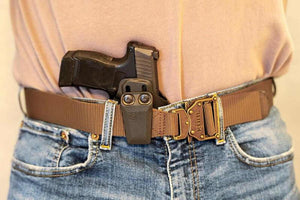If you are going with appendix carry—or any concealed carry method, really—there’s one golden rule: don’t rock your favorite “9mm is faster than 911” tee.
We agree with the message, of course. But that just would be tactical. It would be a funny moment, though.
It’s also a good reminder of what appendix carry is really about: minimizing printing while keeping a fast draw. Sure, it can be a little uncomfortable at first, but with good technique, it can be the safest way for staying protected when outside of home.
Wondering what’s the best position for concealed carry? In this guide, we’ll break down the pros and cons of appendix carry, how to dial in your AIWB holster, EDC belt, and carry angle… and how to choose the right clothes for your self-defense carry setup.
What is Appendix Carry?
Appendix carry means carrying your pistol right in front of your waistband, tucked between your belly button and hip. Makes sense, as that’s the appendix area. It’s one of the most popular options for everyday carry (EDC).
To cut it short: for appendix carry, you need a good AIWB holster (Appendix Inside the Waistband) and an EDC belt. But we’ll dive into all that in just a bit.
Most folks run their setup slightly off-center, tilted toward their dominant side. That’s around the 1 or 2 o’clock position for right-handed shooters, or 10 or 11 o’clock if you are left-handed.
We’ll also talk about the 12 o’clock position, right in front of the hip. It plays a big role in appendix carry, especially for common real-life scenarios, as we’ll break down soon.
There’s always debate around appendix carry vs strong-side carry. We won’t go deep into it here, but in case we have any newer shooters reading this, here’s a bit of context: strong-side carry means you are carrying behind your hip, typically at the 3, 4, or 5 o’clock position. Some find it more comfortable or slightly safer. Others favor appendix carry for better access and concealment.
So, is appendix carry safe? Yes, it is. But as the NRA points out, no carry position is magically safer than the others. Any concealed carry method requires proper safety, good gear, and consistent training. Period.
So why is appendix carry so popular for self-defense? Let’s get into it.
Pros of Appendix Carry
Easy Access and Quick Draw
Let’s start with what many shooters consider the biggest benefit: appendix carry gives you faster access to your gun. Some folks say the draw feels more natural, especially from the 1 o’clock position compared to strong-side at 4 or 5 o’clock.
But, like anything else, it all depends on how you train. Most shooters start out learning from strong-side carry. Then, when they get more focused on self-defense, they adjust and transition to appendix.
Still, the speed advantage is real. In high-stress situations—and especially in tight spaces or close encounters—appendix carry lets you get to your gun faster and cleaner. That alone makes it worth considering for anyone carrying for self-defense.
Retention and Safety
Then there’s retention. With appendix carry, your gun stays right in front of you, in your line of sight and under your control.
Compare that to off-body carry—a bag, purse, or sling—something we see a lot these days. The moment you set it down to do something else, you have lost control.
Instead, with appendix carry, your pistol sits in a spot that’s harder for someone else to access without you noticing.
A lot of people focus on where the muzzle is pointing when talking about appendix carry safety. While that’s a true and fair concern, safety also means keeping your hands on your gear, and your gear in your control.
Better for Concealability
Appendix carry is one of the easiest positions to conceal, especially with the right holster and clothing. Like we mentioned earlier, printing (when the shape of your gun shows through your shirt) is a real concern for concealed carriers. Appendix carry helps minimize it.
With the right setup, your pistol disappears under your shirt. Strong-side or hip carry, on the other hand, tends to print more,especially when you bend or reach.
Comfort
And finally, here’s something people don’t talk about enough: appendix carry can actually work well when you are sitting. Whether it’s driving, eating out, or just hanging around, drawing from the front is often easier than reaching behind your hip.
Of course, any concealed carry will be a bit uncomfortable, especially when you are just beginning. But that’s part of the point, you are carrying something extra, you need to be aware of where it is.
But comfort is personal. It all depends on your body type, what you are doing, and even the weather. Some folks still find appendix carry uncomfortable and of course, maybe it is just not for them.
Cons of Appendix Carry
Safety (and Your Femoral Artery)
Let’s address the first concern we always hear with appendix carry: the direction where the muzzle is pointing. Yes, we know that picture can make people uncomfortable.
It’s true, when carrying appendix, the muzzle does point toward your groin area. Some folks worry about the femoral artery. If something were to go wrong, that could be a death shot.
Good to clear one point here: if you are carrying at the 12 o’clock position, your muzzle is not aiming at your femoral artery. That runs down your inner thighs, not directly in front of your body. So perhaps that can help some people feel a bit safer with appendix carry.
Uncomfort: What’s Real and What’s Just Myth
If someone says that you can’t sit with appendix carry, that’s totally false. You can absolutely sit while appendix carrying, but you just need to adjust.
Here’s a quick trick that works especially well with the 12 o’clock position: Before sitting down, grab your belt or clip and shift it up slightly. That lifts the holster and angles it more toward your belly. It takes the pressure off your waistband and makes sitting much more manageable. This works great for chairs or sitting in a car with appendix carry: just pull the belt up a touch, then sit and drive like normal.
Also, you may hear people say that you can’t pick things off the ground when you are carrying appendix. That is another myth. You can absolutely pick things up, you just have to do it in a specific way:
The ancient and humble art of squatting.
Yes, it’s that simple. And also, better than bending over, keeps you from hurting your back.
What we must agree is that appendix carry may not be the best option when people need to spend long hours standing. Say you are working a shift on your feet, talking to customers, walking around a shop. Over time, the holster tends to shift or ride lower. You might find yourself adjusting it often, which can be a real bummer.
In those cases, strong-side carry may be a better fit. It keeps the pressure off your front and lets you stand more naturally.
Draw Visibility
Another downside is that the draw can be more visible. You are reaching toward the front of your body, which some people notice more easily than a sweep from the side. If total stealth is your priority, it’s something to keep in mind.
The Real Risk: Reholstering
Most accidents with appendix carry happen while reholstering. Yes, that’s a fact. When people are putting the gun away, they just need to keep focused on doing this properly. Safety doesn’t stop when you are putting your gun away.
A with any kind of weapon you may carry: You need to take your time, reholster slowly and with intention.
Tips for Safe and Comfortable Appendix Carry
Best Clothing Choices for Appendix Carry
Let’s start with what you wear. Appendix carry adds bulk inside your waistband, so you’ll need to adjust your outfit just a bit:
-
Go a size up on pants or pick something with stretch.
-
Skip tight waistbands. You’ll want extra space to keep it comfortable.
-
Avoid slim-fit shirts that can print easily.
-
And perhaps the only fashion tip here (haha!): dark colors help conceal outlines, and patterns do a great job of minimizing noticeable printing.
What Makes a Good EDC Belt
Your regular belt won’t cut it. It’s going to loosen up, twist, and mess with your draw. Instead, get a proper EDC belt, purpose-built for concealed carry.
If you have got a bigger frame, consider a 1.5” gun belt with infinite adjustment. Some Velcro-style belts work great too.
Whatever you choose, your belt setup plays a massive part in comfort, control, and draw consistency. Your belt and holster for appendix carry have to be the perfect
Get a Great AIWB Holster
An AIWB holster, specifically designed for the appendix carry position, should offer strong retention and include a claw or wedge to tuck the grip inward. It should also protect the trigger completely and be comfortable for all-day use. So, all-Kydex holsters are out.
The best appendix holsters combine smooth, high-quality materials like leather-lined or Ventcore-backed builds that flex and breathe.
Take our own 45 Blast Yedi Holster, for example. These work great for appendix carry with Canik SC/MC pistols. Their Ventcore design maximizes airflow, fits with comps and red dots, and gives you secure retention plus all-day comfort.
Also, hand-built in the USA. What else can you ask for? You can check the 45 Blast Yedi Holster here.
What you should avoid by all means is using a strong-side holster for appendix. It just won’t sit right—and it can create safety issues.
Train for Concealed Carry
As we always say in the gun community: practice, practice, practice. Take a CCW course—it’ll put you on the right track. The NRA offers great classes that cover draw techniques, safe reholstering, and defensive tactics for real-world encounters.
Are Subcompacts Better Than Full-Size for Appendix Carry?
Here we’d like to question a common take. Yes, size matters, but not the way most people think.
Some larger shooters find that full-size pistols actually work better for appendix carry. You can seat more of the gun inside the waistband, which makes it more stable and less likely to shift. In contrast, subcompacts can ride up, move around more, or even fall out at awkward angles if the setup isn’t right.
So, as you can see, it’s all about your body size and what works best for you. Don’t rule out a full-size pistol just because someone online said subcompacts are “easier.”
The Best Way to Appendix Carry Without Printing
The short answer to all of this is: Get the right AIWB holster. Get the right belt. And practice.
As for what you wear, stick to stretcher clothes. And leave the “I love guns” shirt for another occasion.
That’s it. That’s how you make appendix carry comfortable, safe, and invisible.
So here’s the next move: Drop by the 45 Blast store and grab your new favorite holster.
And hey, we want to hear from you. What’s your go-to concealed carry position? Appendix or strong-side? Tag us on Instagram, show us your setup. We see you practicing. We see you on the range.



